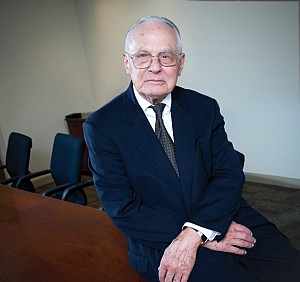Profile of Excellence: Dr. Frank C. Spencer
 Chairman Emeritus, New York University School of Medicine
Chairman Emeritus, New York University School of Medicine
63rd AATS President (1982-1983)
Self-reliance, problem-solving, and a strong work ethic were part and parcel of Dr. Frank C. Spencer’s upbringing on a farm six miles from Haskell, TX, a small farming and ranching community in the Texas panhandle. He started attending school, riding the three miles from the family’s ranch bareback on a horse, when he was six years old. He entered college at North Texas State when he was 15, as the youngest freshman at the school.
During his final year of college, WWII was raging and Spencer was commissioned in the Navy, contingent on his attending medical school. After the two medical schools in Texas rejected him because he was too young, he applied to Vanderbilt University and entered medical school there just before his 18th birthday. At Vanderbilt, Spencer flourished and was eventually valedictorian of his class. With the support of his advisor neurosurgeon Dr. Cobb Pilcher, dean of the Medical School, who had a personal relationship with Alfred Blalock, he was accepted at Johns Hopkins Medical School in Baltimore. At Johns Hopkins, internship and residency were tough, even draconian by today’s standards; interns were on call 7 days a week, 24 hours a day.
Spencer eventually left Hopkins to continue his training at the University of California, Los Angeles (UCLA), under Dr. William Longmire. While at UCLA, the Korean Conflict broke out and Spencer was called to active duty. He was sent to Korea as the chief of surgery in a forward marine unit: EZ Medical Company, 1st Medical Battalion—the ‘‘Cheaters of Death, just two miles behind the enemy lines.’’ At that time, ligation of an affected vessel followed with amputation, rather than primary repair, was the accepted practice for arterial injury and, in fact, was official policy of the US Navy. When Spencer saw his first young patient with a femoral artery injury fresh off the front he was faced with the dilemma. Should he follow official orders and amputate potentially salvageable limbs, or face court-martial by repairing the artery. He chose the latter. With an 80 to 90 percent success rate for his approach, Dr. Spencer was not court-martialed, but awarded the Navy’s Legion of Merit Award for exemplary service. Of his recognition, Dr. Spencer said “…arterial repair in Korea benefited more people than anything I’ve ever done.”1 He returned to his surgical training under Blalock at Johns Hopkins in 1953, completed his residency in 1955 and stayed on as faculty from 1955 to 1961, primarily developing a vascular surgery service.
Spencer then spent five years at the University of Kentucky before accepting his ultimate position as the George David Stewart Professor and Chairman of Surgery at New York University (NYU) in 1966. NYU at that time did not have a cardiothoracic surgery service so, as was typical of Spencer, he started again from scratch. Spencer’s first resident at NYU was Dr. George Green, who studied direct revascularization with the left internal thoracic artery. Spencer had initial misgivings because of his experimental work that suggested that the thoracic artery would be too small to make a significant difference. Green, after receiving permission from Spencer, performed the first internal thoracic–left anterior descending bypass at the Manhattan Veterans Hospital in February 1968. Spencer reminds us, ‘‘My contribution [to thoracic grafting] was giving Green permission to do it, even though I thought that it was probably a waste of time.’’ This was typical. During his 32 years as chairman he continually encouraged his staff and trainees to push the envelope. He described the innovative surgeon as exhibiting a “restlessness with an unsatisfactory status quo combined with a willingness to explore the unknown with its hazards and uncertainties.’’ It was Dr. Spencer’s work and leadership at New York University, in techniques such as coronary artery bypass grafting that became the basis for what is now modern cardiac surgery.




